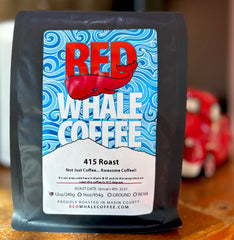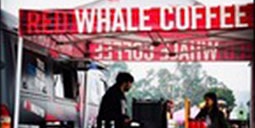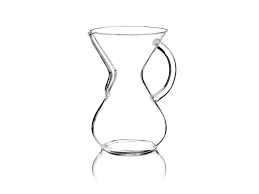This beautiful Mexican Nayarita Reserva Coffee has a nice clean taste, full of chocolate, 60% cacao with hints of cinnamon, caramel and coconut. Soft tannins with medium acidity...loving this coffee! So stoked to have this coffee back in house!
Stop by for a delicious cup and pick up couple bags for your home, family and friends.
Here is a link to order online:
Harvest season: 2017/2018
Country: Mexico
State: Nayarit
Community: El Cuarenteño
Producing Organizations (Coops): BASILIO and PROCAA
Type: Grupo Terruño Nayarita Reserva Washed SHG
Lot size: 25 bags (69kg bags)
Altitude: 1150m
Variety: 55% Arabica Typica, 45% Caturra
Give the gift of Red Whale Coffee with a special eGift card!
Purchase a gift card today in any amount and make their gift one they'll truly love to use.
Click on the link:
https://squareup.com/gift/36ZWGYEPTWP9V/order
Experiencing a Red Whale Cupping

The table is set. Cups arranged in a precise row, trays of sample-roasted beans sit before it, tasting spoons lined neatly along the table, and cupping sheets roosted on each of our clipboards. In the cups, freshly ground coffee from our producer’s sit, awaiting hot water and the start of the cupping.
Coffee cupping is serious business. Everything from the water temperature to grinding the beans fresh to timing each step of the cupping matters. A cupping takes concentration and developing one’s palate to the sophisticated range of flavors each cup offers.
Why is cupping important?

A cupping is a coffee tasting. The cupping allows Q-Graders and other coffee aficionados to grade the coffees and decipher the cupping notes of each coffee. This is also part of the dynamic nature of direct trade coffee, we can communicate with producers after the cupping and discuss what defects were found or where the coffee was exceptional. The producer sends samples of their green coffee beans to the roaster, who roasts and then cups them to pinpoint which beans to buy.

The Different Steps of a Coffee Cupping
Fragrance/ Aroma:

After grinding the coffee, the cupper will take in the aroma of the freshly ground coffee, while surveying the whole beans on the table to note quakers and other defects visible to the eye. The cupper scores the dry coffee and notes which fragrances he picks up.

After judging the dry aroma, the cupper adds hot water to the cup, wetting all grounds and filling it to the brim. After the coffee sits for three to five minutes, the cupper “breaks” the crust, cracking the grounds at the top of the coffee and swirling it with the spoon three times to bring up the aroma.
Tasting:
After notes are gathered on the aroma, it’s on to the next step, tasting the coffee! Coffee is tasted when it has reached the right temperature to sip (a burnt tongue will ruin the tasting experience).
The sip:

Tasting coffee requires that you take a quick sip in. Don’t be afraid to slurp! This quick slurp allows you to pull the coffee into your mouth and taste it across your entire palate.
The first step of evaluating the coffee happens when it has reached around 160 degrees. At these hotter temperatures, one rates the flavor and aftertaste. Next the acidity, body, and balance are rated. As it cools down to room temperature the sweetness, uniformity and cleanliness is evaluated. Then the coffee is added up and scored.
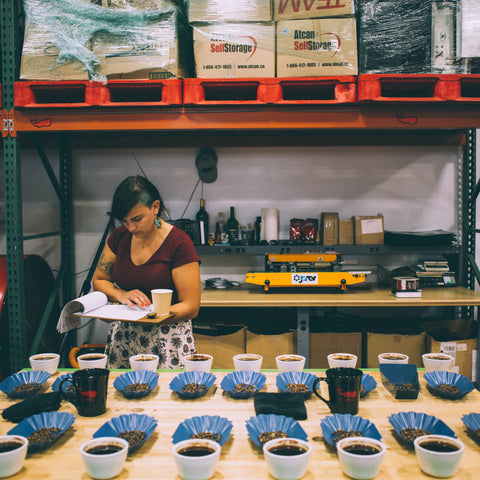
Watch out for defects!
A defect is when something is “off” in the coffee. These negative flavor characteristics can come off as an aroma (or taint) or in the taste (as a fault). These cause the score in intensity to be rated lower (taints are scored at 2, and faults at 4). A defect can have a description like rubbery or sour; those tastes that make you cringe.
The Final Breakdown:

Each of these characteristics helps the cupper break down different aspects of a good cup of coffee. It is then scored and receives a grading 0 and 100. Red Whale Coffee only serves specialty-graded coffee, which means no scores lower than 80 will be served.
Stay tuned for more information on a coffee cupping at Red Whale Coffee! Become part of the coffee process and get the opportunity to learn more about the different characteristics found in coffee.
Blog by Caitlyn Prien

Competition was Fierce and the Coffee was Delicious in Panama Last Week!
Sean has made his way back from Panama! He was invited to be a judge at the Best of Panama. Together with other select judges, Sean cupped and tasted the most beautiful coffee Panama had to offer. It was an honor to be invited to be a part of this panel of specialty coffee judges.
As a member of the coffee community since 2003, Sean has been roasting coffee to bring out the delicate flavors of coffee without over roasting the beans. His culinary background gives him an edge in recognizing flavor characteristics in each bean and recognizing what flavor profiles give the bean strength and should be brought out. This year he joined the elite coffee brigade of Q-graders. Giving him the certification that recognizes his ability to detect the subtle notes within a wide array of coffee. His time in coffee has given him a chance to develop friendships with coffee producers that he treasures. The honor of being invited to participate in the Best of Panama is not taken lightly.
The Specialty Coffee Association of Panama hosts this event yearly. In the tasting, a collection of well-respected coffee professionals take part to score the coffee. Through the course of four days the judges extensively cup the coffee noting defects, flavor characteristics, and the overall quality of the coffee. Sean was honored and ecstatic to score tables with coffee scored in the 90+ range after he and his fellow coffee aficionados were done cupping. Sean recollects that one of his favorite parts of the Best of Panama was coming together with all of the other judges to meet, collaborate, and discover what coffees Panama had to offer this year.

(Coffee judging grows fierce as judges discuss a taint found in one of the coffees)
This detailed analysis of the coffee gives the producers recognition for the rigorous work they have put into growing their coffees. Panama has become a popular market for coffee across the world. The country continues to boast an array of exceptional coffees and a community of dedicated and passionate producers. With the Best of Panama, international coffee buyers and roasters can grasp how serious Panama is about their coffee.
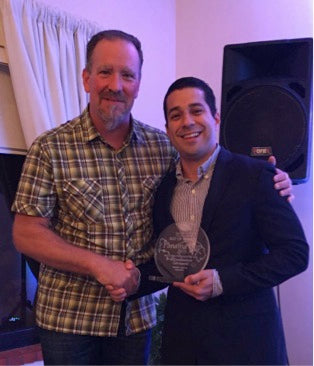
(Sean Boyd and Wilford Lamastus Jr. after his family’s farm won Best of Panama)
In past years, Red Whale Coffee has carried the Lamastus Family’s award winning Elida Geisha. This year, Sean had the opportunity to congratulate them in person for winning the Panama Cup for Best Producer! Come in to check the coffees we have to offer from Panama and stay tuned to see what coffees we may be carrying from this years Best of Panama! Stay tuned for pictures and information about his trip to the Elida Estates and other coffee producing farms while in Panama!
Written by: Caitlyn Prien
You have your delicious bag of Red Whale Coffee, you can’t wait to brew it up and drink it at home. What are you using to brew it? For the best quality of coffee, considering your brewing equipment and brewing process is important. We have a variety of different brewers available for you to consider. Let’s walk through some frequently asked brewing questions and a few suggestions for home!
How should I store my coffee at home!?
This is a question we are often asked. A common myth is that it is best to store your coffee in a freezer. This is a myth. The freezer destroys the oils in the beans and makes the coffee flat, killing the flavor. The best place to store coffee is in the original Red Whale Coffee bag but if you must transfer your coffee to a container, a sealed glass container, like a Ball Jar or airtight container. Store your beans in a cool place with no sunlight exposure.
Grind: How fine should my grind be?
For the best cup possible, we recommend grinding your coffee immediately before brewing. When the bean is whole, the flavors are sealed inside. After grinding coffee, that flavor is released, meaning that grinding it even hours before you make your coffee will deplete the flavor you enjoy. When a coarser grind is recommended when using a metal filter. When using a paper filter, a finer grind will give you the best result. A coarse grind for coffee allows water to pass through too quickly and if your coffee is ground too fine, the water will have trouble going through the filter, blocking a proper coffee extraction. Stay tuned for more information in February on what sort of grinders we recommend for home use!
Brewing Methods: How much coffee do I use to make my cup?!
We recommend a half-ounce or one tablespoon to each measured cup of water for the proper extraction. Coffee is a very personal experience and there are many varieties of coffee. We can help guide you through the world of coffees to find your perfect coffee fit. Experiment to find your personal preference, brewing methods can either bring out more flavor and oils or less, leaving you with a clarified cup! It’s all a good excuse to drink more coffee!
A question commonly asked: What is the difference between using a paper filter or a metal filter?
A paper filter will give you a cleaner cup; allowing only the liquid to pass through, with no sediment at the bottom of your cup. A grind of 5 is a nice fine grind for a paper filter, you could go a little finer, but be careful! Or the water will not be able to move through the grind.
Extracting coffee with a metal filter creates a deeper cup experience by allowing the fine coffee particulate and oils to pass through the filter, adding depth and a texture to your cup. For the metal Able Kone a coarse grind of about 7 is recommended, but play around to your personal taste.

We offer both paper and metal filters at Red Whale Coffee. The metal, Able Kone filter is made locally in the Bay Area (support local) and is a perfect addition to your home brewing routine. A group of coffee lovers, wanting a sustainable filter option for their Chemex maker, were inspired in the technology and design, to develop a filter that provides the best possible cup.
Brewing Equipment Recommendations
Chemex
If you want a coffee brewer that withstands the test of time, we recommend the Chemex. Invented in 1941, the Chemex is a classic coffee brewer that continues to be one of the best options for coffee brewing. The simplicity of its glass design gives it a modern look, while being functional and heat proof. For the maximum quality of your cup, we recommend pairing it with the Able Kone. The sleek hourglass Chemex shape paired with the Able Kone, is nice look for serving. The coffee can also be stored in the Chemex, sustaining the quality flavor it had when first brewed.
Kone Brewing System

Able Brewing in a effort to build upon the Kone Filter, created the Kone Brewing System. Made from ceramic, it is functional and has a clean simple design, making it ideal for serving to guests or storing the coffee for later use.
AeroPress

The AeroPress Brewer is ideal for travel and making your coffee by the cup. It is economical, easy to clean, and portable. It has a speedy brew time that allows the coffee to have a gentle taste to it, with little room for bitterness. Because the coffee is completely immersed, the extraction is uniform, without a chance of over extraction. It can be used with a paper filter or a metal filter; the AeroPress includes a micro filter to allow rich tastes without the grit and it is made from plastic that is BPA and pthlalates free. A great addition to your vacation getaway or a casual day around the house.
Come down to Red Whale Coffee to check out these brewing systems and our other pour over methods by Melitta and Hario! We are happy to answer any brewing questions that help you get the most out of each cup that you sip at home or in the office!!
Written by: Cailtyn Prien
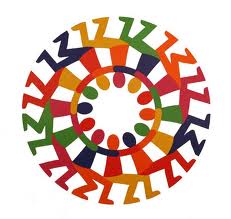
As 2014 winds to a close, Red Whale Coffee reflects on our growth, opportunities, and friendships that were realized this year. Red Whale Coffee is as much about the people as it is about the coffee; it wouldn’t be Red Whale without all of the wonderful people who contribute to our coffee community!
There are so many, but to thank you all would create a list lasting days, so we will keep it short and name just a few! Thank you all for supporting us and brightening us with your ways!
Special thanks to Steve and Andy who meet here to stay sane and connected during their work days,
Tom, Linda, Chuck, Debra and “Miguel the Mayor”,
Ben, who drives a big white truck,
Cheerful Larry and of course, Craig and all their friends from the County,
Ben, Adam, Angie and Shirley from Kaiser next door,
We can’t forget Mike, Peter and Dr. Matthew Egan,
Marci or Daphne
Great neighbors continue in Warm Things, California Printed of Marin, TLC and Graf!
All of our friends at the YWCA who give us reasons to smile with their every visit,
TRI Studio with Rick’s calm and chill demeanor, including all of the colorful people he brings in with him
Pelo and Star Academy; for all the coffee lovers that work there
Luke with his marketing team and Joe with his never-ending web development support….
Lillian, Sunshine Designs, Sammy Hagar and his guitarist, Vick too!
Where would we be without our coffee producers?
Remembering them for all their hard work in producing quality products, we are especially grateful to Yoddoi Thailand Coffee, Nayarita Coffee, Santa Felisa, and Elida Estate, to name just a few.
We are truly blessed and happy to have all of you as part of the Red Whale Coffee Family! We look forward to and can't wait to see what next year brings! THANK YOU!
Written by: Caitlyn Prien
On the first day of Christmas
My true love sent to me
A Red Whale mug, full of coffee
On the second day of Christmas
My true love sent to me
Two bags of beans,
And a Red Whale mug, full of coffee
On the third day of Christmas
My true love sent to me
Three fresh made pastries,
Two bags of beans,
And a Red Whale mug, full of coffee
On the fourth day of Christmas,
My true love sent to me
Four insulating travel mugs
Three fresh made pastries,
Two bags of beans,
And a Red Whale mug, full of coffee.
On the fifth day of Christmas,
My true love sent to me,
Five glass Chemex,
Four insulating travel mugs,
Three fresh made pastries,
Two bags of beans
And a Red Whale mug, full of coffee.
On the sixth day of Christmas,
My true love sent to me,
Six Baratzas a'grinding
Five glass Chemex
Four insulating travel mugs,
Three fresh made pastries,
Two bags of beans,
And a Red Whale mug, full of coffee.
On the seventh day of Christmas,
My true love sent to me
Seven soft sweatshirts a'warming,
Six Baratzas a'grinding,
Five glass Chemex,
Four insulating travel mugs,
Three fresh made pastries
Two bags of beans,
And a Red Whale mug, full of coffee
On the eighth day of Christmas,
My true love sent to me
Eight Melitta cones a'brewing,
Seven soft sweatshirts a'warming,
Six Baratzas a'grinding,
Five glass Chemex,
Four insulating travel mugs,
Three fresh made pastries,
Two bags of beans,
And a Red Whale mug, full of coffee
On the ninth day of Christmas,
My true love sent to me
Nine latte bowls brimming,
Eight Melitta cones a'brewing,
Seven soft sweatshirts a'warming,
Six Baratzas a'grinding,
Five glass Chemex,
Four insulating travel mugs,
Three fresh made pastries
Two bags of beans,
And a Red Whale mug, full of coffee
On the tenth day of Christmas,
My true love sent to me
Ten Red Whale hats a'capping
Nine latte bowls brimming,
Eight Melitta cones a'brewing,
Seven soft sweatshirts a'warming,
Six Baratzas a'grinding,
Five glass Chemex,
Four insulating travel mugs,
Three fresh made pastries
Two bags of beans,
And a Red Whale mug, full of coffee
On the eleventh day of Christmas,
My true love gave to me
Eleven Aeropress pressing,
Ten Red Whale hats a'capping
Nine latte bowls brimming,
Eight Melitta cones a'brewing,
Seven soft sweatshirts a'warming,
Six Baratzas a'grinding,
Five glass Chemex,
Four insulating travel mugs,
Three fresh made pastries
Two bags of beans,
And a Red Whale mug, full of coffee
On the twelfth day of Christmas,
My true love gave to me,
Twelve Hario drippers dripping,
Eleven Aeropress pressing,
Ten Red Whale hats a'capping
Nine latte bowls brimming,
Eight Melitta cones a'brewing,
Seven soft sweatshirts a'warming,
Six Baratzas a'grinding,
Five glass Chemex,
Four insulating travel mugs,
Three fresh made pastries
Two bags of beans,
And a Red Whale mug, full of coffee
Happy Holidays from all of us at Red Whale Coffee!
Written by: Caitlyn Prien
Red Whale Coffee proudly offers two delicious decaf coffees, a Mexican Swiss Water Decaf and a Sumatra Swiss Water Decaf!

http://spanishdialects-09b.wikispaces.com/file/view/coffee_woman.jpg/105800813/coffee_woman.jpg
How is the naturally occurring caffeine extracted from coffee you wonder? You may even ask yourself why some decaf coffees have no flavor while others are tasty? The answer is in the process method used to extract the caffeine from the bean.
All coffee is decaffeinated using water to wash the caffeine from the bean. The end result taste differences come from the process that also extract the oils and flavor complexity compounds from the bean during decaffeination.

http://www.thrillist.com/drink/nation/how-to-make-decaf-coffee
The Different Methods
The Indirect Solvent Based Decaffeination Process is popularly termed the “European Method” and requires boiling green coffee for hours to extract the caffeine. The beans are soaked in chemicals like methylene chloride or ethyl acetate, which bond to the caffeine for easy extraction. The beans are then heated, burning off the chemically bonded caffeine. The process continues by soaking the bean again in the original liquid to recollect the flavor compounds and oils striped from the bean in the first step of the process.
The Direct-Solvent Based Process is often referred to as the Natural Decaffeination Method or the Ethyl Acetate Method. This process starts by steaming the beans rather than boiling them. The bean pores open and are washed for approximately ten hours with Ethyl Acetate, a compound found naturally in fruit. The caffeine adheres to the Ethyl Acetate and is then separated from the bean. The beans are steamed again as the final step in ridding any residual caffeine bonded to the Ethyl Acetate.
The Carbon Dioxide Method (CO2) is often used for commercial grade coffee because large quantities can be processed at a low cost. In this process, a liquid form of CO2 is mixed with water soaked green beans. Unlike the ethyl acetate or methylene chloride, CO2 only bonds with caffeine, leaving the flavor compounds and oils in the coffee. Once the caffeine has been extracted, the CO2 (now laden with caffeine) is pressurized back to a gaseous state, separating the caffeine from the gas which then allows the CO2 to be reused in repeated decaffeination processes.
The Swiss Water Process, the only decaffeination process sourced by Red Whale Coffee, is the only process that does not use chemicals to extract caffeine from the beans. The Swiss Water Decaffeination Process soaks the bean in near boiling water, extracting the caffeine and while leaving the flavor in the coffee. The caffeinated water is then filtered through a charcoal filter that catches the large caffeine molecules and allows the smaller flavor molecules to remain in the water. This process, referred to as the "Green Coffee Extract", allows the water to retain its natural flavors without the caffeine. The final process of returning the flavor to the bean, which is used in all other decaffeination methods, is not needed in this method. The Swiss Water Process is also, the only process recognized as environmentally friendly, sustainable and approved for organic coffee beans.
Familiarizing yourself with the different processes for decaffeination is helpful when choosing your beans. The different processes have varying successes in keeping the robust flavor of the coffee bean without the naturally occurring caffeine.
We invite you to come see us at Red Whale Coffee to try our new Sumatra Swiss Water Decaf! Now that you know the process you can taste the result!
Written by: Caitlyn Prien

http://quotes.lol-rofl.com/christmas-coffee-art/
The holidays are approaching, with the hustle and bustle that coincides it’s easy to lose track of what goes on in the rest of the world. Although there are no specific holiday rituals associated with the coffee communities where we get our beans, there are richly diverse cultures that celebrate the holidays in different ways. As a fun perspective and to distract you from your impending holiday obligations, here are a few cultural holiday traditions from the countries where we source our coffee.
In Panama, Christmas is a favorite holiday. There are many month long festivities, turning Christmas into a festival for the community rather than just a family oriented celebration. Two weeks into December, a Christmas Parade takes over Panama City. The children from lower income families are invited into the middle of the festivities so that they can be embraced by the celebration. The costumes are elaborate, where women wear polleras, beautiful dresses, complimented with hairpieces (or tembleques) and other jewelry.

http://www.theculturalvoyager.com/wp-content/uploads/2013/02/Blue-Pollera.jpg
Other parts of the celebration include Christmas tree lightings on the beach followed later in the evening with boat parades featuring ships ornamented with Christmas lights and decorations.
Las Posada is held the nine days leading up to Christmas. Small neighborhoods host parties at their houses to replay the search Mary and Joseph went through to find shelter. They parade around the neighborhood and at the final house they are welcomed and a party is held there. On Christmas Eve at midnight, a beautiful fireworks display is set off to announce Christmas. A nighttime feast commences with dancing and celebrating all throughout the streets of Panama City.

http://media.sacbee.com/static/weblogs/photos/images/2010/dec10/christmas_lights_sm/christmas_lights_09.jpg
In Guatemala, holidays are celebrated frequently in small villages with fireworks, traditional dance, and El Boj, a potent drink made from sugar cane, also known as White Lightning. Guatemala has a mixture of different cultural influences, from different regions, ethnic and cultural groups who all celebrate the holidays a little differently. For instance, the Garifuna people from the eastern coast of Guatemala whose traditions are strongly influenced by Caribbean cultures; celebrate with a Guatemalan Carnival. These unique carnivals are celebrated from Christmas until New Years and the Garifuna people lead the celebration with their dance and music.
Guatemalans participate in many other Holiday celebrations and they all have the native music, dance and traditional dress in common. While there are many kinds of traditional festivities around Christmas, there is a centralized celebration for New Year's Day. It is tradition that on the first day of the year, Guatemalan people wear new clothes believing it will bring luck for the upcoming New Year.
Ethiopia celebrates a variety of different holidays; most of them are based on Christian or Muslim traditions.

http://theforsakenchildren.org/wp-content/uploads/2012/11/horse-riding.jpg
Christmas is called Ledet, which is celebrated after fasting for 43 days during Advent, or Tsome Gahad. Christmas is celebrated with a procession that starts at 6 AM and lasts until 9AM. A Christmas Mass is held, and then the families come together to break the fast of Tsome Gahad.
In bigger Ethiopian cities holiday celebrations consist of horse races and folk dances. Often times, people come together to play a hockey like game called Yegena Chewata, played with a ball and stick. As the legend goes, this game started when the shepherds hearing of the birth of Jesus, jumped about excitedly throwing objects into the air while batting them with sticks. This game is now widely played on Christmas.
These are just a few holiday traditions celebrated in the countries where we get our coffee. There are many diverse traditions, all as rich as our coffee from all around the world. When setting up your holiday list, visit us online www.redwhalecoffee.com or stop by Red Whale Coffee in San Rafael, to pick up a bag to stuff in a stocking or to serve with friends and family!
Written by: Caitlyn Prien
The history of coffee is as rich as the beverage. It started in Ethiopia, with the tale of the goat herder, Kaldi, who saw his goats eating berries from a tree. The goats ran energetically after eating these beans, refusing to sleep at night. Kaldi explained this to a monk who from it developed a drink that helped him stay awake through prayer. As the monks traveled so did the introduction of this energizing berry. The legend goes that the monk’s beverage helped in the development of the coffee that we sip today.

http://olaszorszagrol.hu/wp-content/uploads/2014/02/k%C3%A1v%C3%A9.jpg
Coffee was first roasted and brewed in Arabia. Coffee was used in Muslim religious ceremonies and secular life. Coffee spread with Islam, traveling to India, North Africa, and the eastern Mediterranean. The first coffee houses were developed and these public houses became hubs of social activity. As people sipped coffee, they chatted, listened to live music, played chess, watched performers, and discussed current events. Coffee houses became important information centers causing them to be called, “Schools of the Wise” (http://www.ncausa.org/i4a/pages/index.cfm?pageid=68).
Arabia however, did not want to share its monopoly on coffee beans. When exporting coffee beans it is rumored that they would boil them to make them infertile. Legend further claims that a smuggler hid beans strapped to his stomach in 1600’s and these beans became the start of the European agricultural involvement in coffee. Coffee spread to Europe and although initially there were mixed feelings (the “Elixir of the Devil” was a term that did not inspire much confidence in drinkers), coffee made it’s way into the heart of Europeans. The pope tried coffee to see if it truly was Satan’s drink. He enjoyed it and not tasting Satan’s influence in his cup, he gave it the Papal approval.
Again, as coffee became more widely imbibed, it led to shops that fostered conversation and the spread of knowledge. Much like the Coffee Houses in Arabia, these houses brought together all different people and become centers for ideas and social activity. With all this sharing of ideas, many rulers were concerned about what their subjects were discussing and whether these discussions were promoting revolutionary discussions.

http://blog.evenues.com/wp-content/uploads/2013/11/Turkish-Coffee-House-1.jpeg
The coffee beans that were taken from Arabia were successfully cultivated in Java by the Dutch. Unlike the Arabian coffee growers, the Dutch took a different approach to sharing their coffee plants. They were confident in their coffee producing skills, which led them to lavishly gift aristocrats with branches of coffee trees. They gifted the King of France, Louis XIV, with a branch. This precious commodity was planted in his royal gardens, a symbol of prestige and power.
Though many in Europe enjoyed coffee, the fertile beans were still guarded from most. Gabriel de Clie was a young officer in the French Army stationed in Martinique. He imagined Martinique as the start of a French coffee producing area, while on leave in Paris, his request for a clipping start cultivating coffee trees was denied. In true fashion with coffee history, he smuggled the coffee back with him and in the cover of darkness, he made his way into the royal gardens and took a seedling.
After a dramatic voyage, wrought with pirates, attempted seedling sabotage and storms, the seedling finally made their way to the Americas. The coffee trees sprouted from the stolen branch, growing into the trees that would bring coffee to South America. However, the French were not keen on allowing others to grow coffee in the Americas. Brazil had a secret agenda when visiting the French colony. The handsome colonel, Francisco de Mello Palheta, was to bring coffee beans back to Brazil. Although the French governor denied his request, his wife thought otherwise. Charmed by the colonel, she gifted him flowers the final night of his stay, hidden inside were seedlings which he brought back to Brazil, beginning a new age of coffee production.

http://www.coffeegeneral.co.nz/wp-content/uploads/2012/04/History-of-coffee-image.jpg
Brazil grew into one of the largest coffee producing countries, which allowed coffee to become more than just a drink for the elite. Unlike the history of coffee retold above, the production of coffee today is more receptive to different coffee growers in many areas of the world. Today, coffee producers and coffee roasters share feedback about the beans and work together to produce the highest quality coffee.
Although we don’t have charming colonels stowing coffee in flowers or Dutch smugglers strapping coffee to their stomach, coffee is still just as much of a commodity, stimulating conversation and bringing people together.
Written by: Caitlyn Prien
